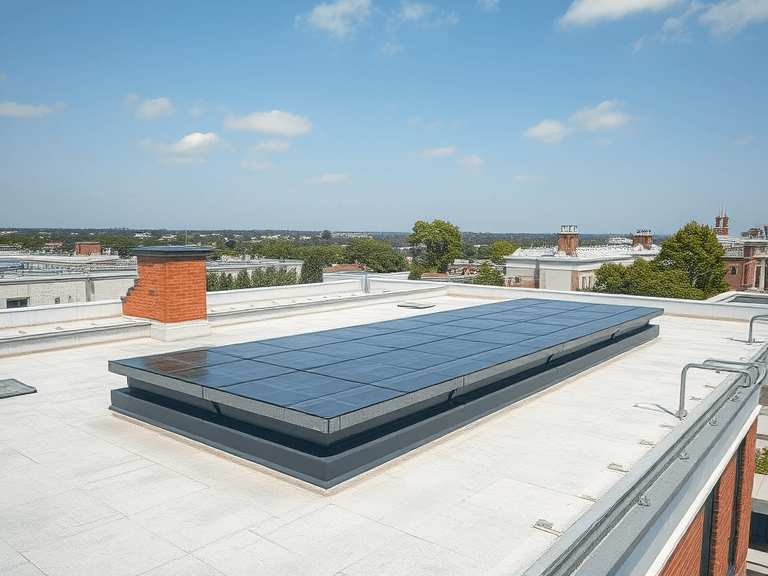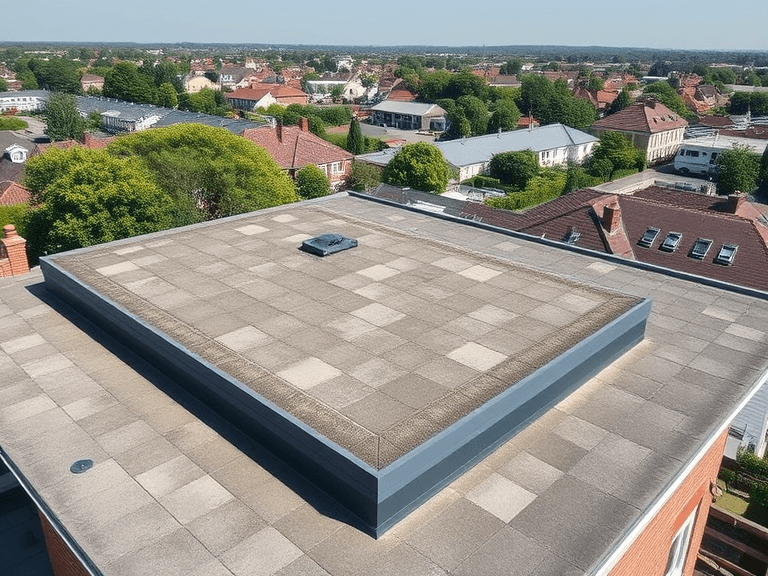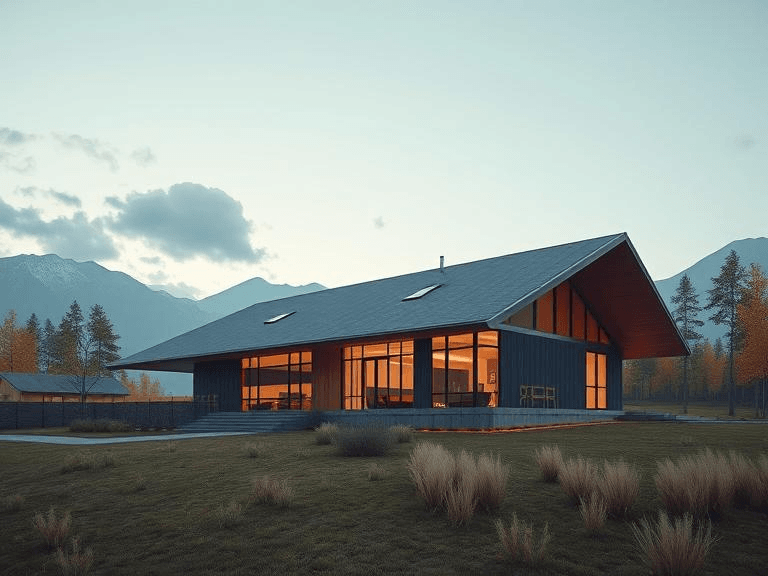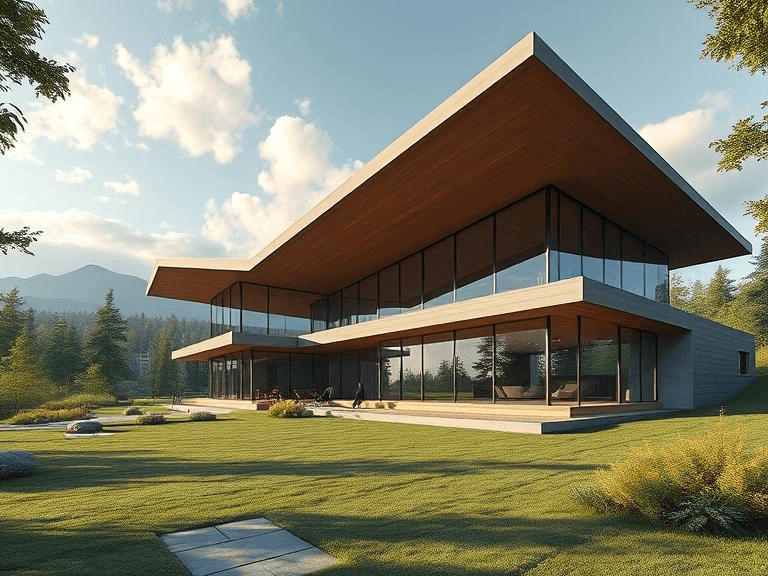
Flat roofing is a type of roofing system characterized by its minimal or no slope, typically ranging from 1 to 10 degrees. This design approach distinguishes it from traditional pitched roofing, making it a viable option for various architectural styles. Flat roofs are predominantly utilized in commercial buildings, but their use has escalated in the residential sector, particularly in modern and minimalist architecture. The aesthetic appeal of flat roofing, combined with its practical applications, contributes to its rising popularity among property owners.
The construction of a flat roof generally involves several layers, including a waterproof membrane, insulation, and a protective layer. As a result, flat roofing can be designed using various materials, such as modified bitumen, TPO (thermoplastic polyolefin), and EPDM (ethylene propylene diene terpolymer), each offering unique benefits tailored to specific climates and building needs. One significant advantage of flat roofs is their accessibility. Unlike sloped roofs, flat roofs provide usable outdoor space, making them ideal for rooftop gardens, solar panel installations, and recreational areas.
However, while flat roofing presents several advantages, prospective property owners must also consider potential disadvantages. The primary concern associated with flat roofing systems is drainage. Due to their minimal slope, flat roofs can be prone to water pooling, leading to leaks or structural damage over time if not properly maintained. Therefore, it is crucial for property owners to consider the local climate, building codes, and maintenance requirements when opting for flat roofing to ensure long-term effectiveness and durability.
In recent years, flat roofs have garnered attention for their energy efficiency. With appropriate insulation and reflective materials, flat roofing can significantly reduce energy costs, making it an attractive alternative for eco-conscious property owners. As the demand for sustainable building solutions increases, flat roofing will likely continue to play a central role in new construction projects.
Advantages of Flat Roofing
Flat roofing systems have gained popularity for numerous reasons, making them an attractive option for many homeowners and commercial property developers. One of the primary advantages of flat roofs is their cost-effectiveness. Compared to traditional sloped roofs, flat roofs typically require fewer materials and simpler construction techniques, which can significantly reduce initial installation costs. Moreover, the straightforward design allows for quicker installation times, minimizing labor costs and expediting project timelines.
Maintenance of flat roofing is generally more manageable than that of pitched roofs. Due to the level surface, homeowners can easily access the roof for inspections or repairs, resulting in reduced costs for ongoing maintenance. Routine upkeep often involves simply clearing debris, checking for damage, and ensuring proper drainage, which can help prolong the lifespan of the roofing system. Many modern flat roof materials are designed to withstand various weather conditions and are resistant to UV rays, making them resilient and durable.
In addition to their cost and maintenance benefits, flat roofing offers unique opportunities for maximizing usable space. Property owners can utilize flat surfaces for various purposes, such as installing rooftop gardens, patios, or even solar panels. These additional features not only enhance the overall aesthetics of the property but also promote sustainable living by providing green spaces or utilizing renewable energy sources. Rooftop gardens can contribute to improved air quality, reduced urban heat, and increased biodiversity, while patios offer valuable outdoor seating areas for relaxation and social gatherings. The versatility of flat roofing serves both functional and aesthetic needs, ensuring it remains a desirable option for many projects.
Disadvantages of Flat Roofing
Flat roofing systems can pose several challenges for property owners, primarily due to their unique design. One of the most significant issues associated with flat roofs is drainage. Unlike sloped roofs that naturally encourage water runoff, flat roofs require adequate drainage mechanisms to prevent water accumulation. If these systems become blocked or malfunction, standing water can lead to increased pressure and potential damage to the roofing material, ultimately reducing its lifespan.
Moreover, flat roofs have a higher risk of leaks compared to sloped roofing alternatives. The absence of a slope means that any penetrations, such as vents or skylights, can become weak points. These areas may allow water infiltration, especially during severe weather conditions. Additionally, the flat surface, when subjected to extreme temperature fluctuations, can expand and contract, further increasing the vulnerability of seams and joints where leaks may develop.
Longevity is another concern for flat roofing systems. While certain materials can extend the life of a flat roof, typically, flat roofs tend to have shorter life spans compared to their sloped counterparts. The average lifespan of flat roofing is generally around 15 to 25 years, depending on materials used and maintenance practices. In contrast, sloped roofs, particularly those made of high-quality materials such as slate or tile, can last 50 years or longer.
Maintenance requirements for flat roofs can also be more rigorous. Regular inspections are vital to ensure that any drainage systems are functioning properly and that there are no signs of wear or damage. Accumulated debris, such as leaves and dirt, can quickly affect drainage and promote mold growth, necessitating more frequent cleaning and upkeep. Thus, while flat roofing may offer certain advantages, potential drawbacks should be considered to make an informed decision.
Cost Analysis: Flat Roofing vs. Sloped Roofing
The choice between flat roofing and sloped roofing extends beyond aesthetics and functionality; it also involves a thorough cost analysis. Understanding the financial implications associated with each type of roofing is crucial for homeowners and builders alike. Initially, flat roofing systems often have lower installation costs compared to sloped roofing. The simplified design requires fewer materials and less labor, leading to significant savings during installation. Various flat roofing materials, such as TPO, PVC, or EPDM, are available at competitive prices, adding to the cost-effectiveness of this option.
However, it is important to note that while the upfront costs may be lower, the long-term maintenance expenses for flat roofs can impact overall financial viability. Flat roofs are often more susceptible to pooling water, which can lead to leaks and other damage if not properly maintained. Regular upkeep such as inspections, cleaning debris, and occasional repairs can add to the ongoing costs. In contrast, sloped roofs, while initially more expensive to install, might incur lower maintenance costs over time due to better drainage and reduced risk of water accumulation.
Another financial aspect to consider is the potential savings offered by flat roofing in terms of energy efficiency. Flat roofs can accommodate solar panels more easily, allowing homeowners to harness solar energy and reduce their electricity bills. Additionally, some flat roofing materials reflect sunlight, leading to lower cooling costs during hot months. In evaluating the overall expenses associated with each roofing style, it becomes evident that flat roofing can provide savings on energy bills, which can offset some of the long-term maintenance costs. Ultimately, the decision should factor in both the immediate and ongoing financial implications of each roofing system.

Material Choices for Flat Roofing
When considering flat roofing, the selection of materials plays a crucial role in the overall performance, longevity, and cost-effectiveness of the roofing system. Each material comes with its unique set of advantages and disadvantages that should be assessed carefully for optimal results. Three of the most common materials used in flat roofing applications are EPDM, TPO, and PVC.
EPDM, or ethylene propylene diene terpolymer, is a widely recognized option for flat roofs. This synthetic rubber membrane is prized for its durability and resistance to environmental stressors, such as UV radiation and extreme temperatures. EPDM roofs can last up to 30 years with proper maintenance. However, installation can be complex and may require professional intervention, potentially increasing upfront costs. Furthermore, while EPDM is generally more affordable compared to its counterparts, it may not be as energy efficient, impacting cooling costs in warmer climates.
TPO, or thermoplastic olefin, has gained popularity in recent years, primarily due to its reflective properties, making it a suitable choice for energy efficiency. The material is lightweight, easy to install, and is available in white, which helps reduce heat absorption. TPO systems can be less expensive than EPDM and PVC, but their lifespan tends to be shorter, averaging around 15 to 20 years. The long-term performance of TPO may also vary based on the thickness and quality of the material.
PVC, or polyvinyl chloride, is another robust material for flat roofing, known for its fire-resistant properties and long lifespan, which can extend beyond 20 years. PVC is particularly effective in areas prone to high foot traffic due to its mechanical strength. However, the higher initial cost can be a deterrent, and installation may require specialized skills, adding to overall expense. Moreover, the environmental impact of PVC production and disposal is an important consideration for some property owners.
Climate Considerations
When evaluating flat roofing systems, it is essential to consider the impact of local climates on their performance and longevity. Various environmental factors, including snow accumulation, heavy rainfall, and extreme heat, can significantly influence the effectiveness of flat roofs. Understanding these climate-related implications allows property owners to make informed choices when selecting suitable roofing materials and designs.
In regions that experience frequent snowfall, flat roofs can encounter challenges related to snow accumulation. Unlike sloped roofs that facilitate efficient runoff, flat roofs may allow snow to settle, leading to potential weight issues and water pooling as temperatures fluctuate. This can subsequently increase the risk of leaks and structural damage. As such, it is advisable to invest in roofing systems specifically designed to withstand heavy snow loads, such as modified bitumen or TPO options that exhibit superior thermal performance and drainage capabilities.
Conversely, areas subjected to heavy rains require careful consideration of drainage systems to prevent water-related problems. Flat roofs need to incorporate efficient drainage solutions, including internal drains and tapered insulation, to steer water away from critical areas. Systems that are well-engineered to manage rainwater effectively will contribute significantly to the roof’s resilience and durability in wet climates.
Lastly, in hotter climates, flat roofs can be susceptible to heat buildup, which may lead to thermal expansion and contraction, resulting in potential damage over time. This highlights the importance of choosing lighter-colored roofing materials that reflect sunlight, helping to mitigate heat absorption. Additionally, insulation plays a crucial role in maintaining temperature control and overall energy efficiency. In essence, adapting flat roofing designs and materials to specific weather conditions is vital for ensuring optimal performance and longevity.
Flat Roofing Maintenance Tips
Proper maintenance is crucial for the longevity and performance of flat roofing systems. One of the primary aspects of maintaining a flat roof is conducting regular inspections. It is advisable to inspect the roof at least twice a year, preferably in the spring and fall, to identify any potential issues such as cracks, blisters, or pooling water. These inspections allow homeowners to address minor problems before they escalate into significant repairs, ultimately saving time and money.
Cleaning is another essential component of flat roofing maintenance. Over time, debris such as leaves, branches, and dirt can accumulate on the roof’s surface, hindering proper water drainage. Regularly removing these materials ensures that water does not pool on the roof, which can lead to leaks and structural damage. It is recommended to use a soft broom or a leaf blower to clean the roof gently. However, caution should be exercised to avoid damaging the roofing material during the cleaning process.
Managing drainage systems is vital for the performance of a flat roof. Clogged drains or downspouts can prevent water from flowing off the roof, leading to standing water, which can compromise the integrity of the roofing material. Homeowners should inspect and clear any debris from gutters and drain outlets regularly. If significant build-up is observed, professional assistance may be beneficial to ensure the drainage system functions correctly.
Finally, addressing minor repairs promptly can extend the lifespan of flat roofing systems. Cracks, punctures, or seams that show signs of wear should be sealed as soon as they are identified. Utilizing appropriate repair materials, specifically designed for flat roofing, is crucial to ensuring the longevity of these fixes. By being diligent about inspections, cleaning, and drainage management, homeowners can maximize the durability and reliability of their flat roofing.
Case Studies: Successful Flat Roofing Applications
Flat roofing has gained considerable traction in recent years, with various successful applications across different types of buildings. Understanding these case studies can provide valuable insights into the effectiveness of flat roofing systems, their design advantages, as well as the functionalities they offer. One notable example is the use of flat roofing on urban commercial buildings, such as office complexes, which often capitalize on limited space in densely populated areas. These buildings leverage flat roofs for green spaces or terraces, thereby enhancing urban biodiversity while providing employees with recreational areas.
Another compelling case study involves residential homes that utilize flat roofing to achieve a modern aesthetic. Many homeowners have embraced this design for its minimalistic appeal and its ability to accommodate various energy-efficient elements, such as solar panels. A particular case of success involves a newly constructed home in a suburban setting, where the flat roof has been integrated with an innovative drainage system, effectively averting water pooling issues. This integration has not only improved the roof’s longevity but has also contributed to the home’s overall energy efficiency.
Furthermore, educational institutions, such as modern schools and universities, have also opted for flat roofing systems. These structures frequently incorporate walking areas or outdoor classrooms that encourage student engagement. A secondary benefit realized in these scenarios is the ease of maintenance associated with flat roofing, making it significantly more manageable compared to traditional sloped roofs. In some cases, however, builders learned the importance of careful planning and material selection to ensure that the flat roofing could withstand various weather conditions and hold up against wear over time.
Through these case studies, it is clear that successfully implementing flat roofing solutions can lead to improved functionality and enhanced aesthetic value. The lessons learned emphasize the need for informed decisions regarding design and material choices, ensuring that the benefits of flat roofing are fully realized in practice.
Conclusion: Is Flat Roofing Right for You?
Choosing the right roofing system is a critical decision that can significantly impact your property’s longevity and value. Flat roofing, with its unique characteristics, offers both advantages and disadvantages that must be carefully considered. On one hand, flat roofs are often more cost-effective to install and maintain compared to their pitched counterparts. They provide additional space for HVAC systems or can even be transformed into a rooftop garden or recreational area. Furthermore, flat roofs typically offer easier access for repairs or inspections, making routine maintenance more manageable.
However, it is essential to recognize the limitations associated with flat roofing. The drainage challenges inherent in flat designs can lead to water pooling if not properly addressed, potentially resulting in leaks and structural damage over time. Additionally, insulation can become a concern due to flat roofs being more susceptible to temperature variations, which might ultimately affect energy efficiency. Therefore, individuals considering flat roofing should evaluate their local climate, as areas with heavy snowfall or rainfall may pose particular risks.
When determining whether flat roofing is suitable for your needs, contemplate factors such as your budget, the aesthetic preferences you have for your property, and the level of maintenance you are willing to commit to. The decision-making process should include a thorough assessment of both the benefits and the drawbacks of flat roofs in relation to your specific circumstances. By weighing these considerations thoughtfully, you can arrive at an informed conclusion that aligns with your expectations and property requirements. Ultimately, flat roofing presents a viable option for many, provided that you are prepared to manage its unique challenges effectively.


